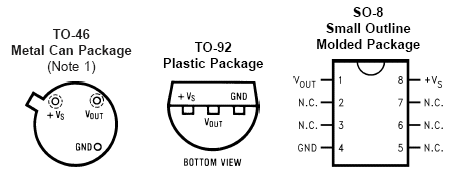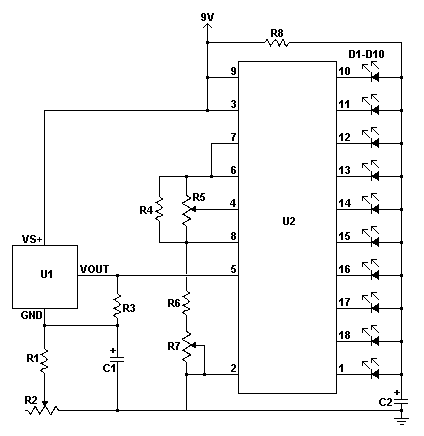This LED thermometer is designed for in home use, to read temperatures between about 60 and 78 degrees Fahrenheit. It is based around a precision temperature sensor IC, the LM34DZ. This sensor require no calibration and can measure temperatures of between -50F and +300F. While the circuit shown here does not use the full range of that sensor, it can be modified to do so by simply changing the voltage reference to U2 at the sacrifice of precision.
| Part | Total Qty. | Description | Substitutions | | C1 | 1 | 1uF 25V Electrolytic Capacitor | | | C2 | 1 | 10uF 25V Electrolytic Capacitor | | | R1 | 1 | 2.2K 1/4W Resistor |
| | R2, R5, R7 | 3 | 1K Trim Pot |
| | R3 | 1 | 1K 1/4W Resistor |
| | R4 | 1 | 1.5K 1/4W Resistor |
| | R6 | 1 | 470 Ohm 1/4W Resistor |
| | R8 | 1 | 100 Ohm Or 15 Ohm 1/4W Resistor (See Notes) |
| | D1 - D10 | 10 | LED |
| | U1 | 1 | LM34DZ Precision Fahrenheit Temperature Sensor |
| | U2 | 1 | LM3914 Bar/Dot Graph Driver IC |
| | MISC | 1 | Board, Wire, Socket For U1 and U2, Case |
|
| |
- The pinout of U1 depends on the version of the IC you purchase. These options are shown below:
- You will want to build the circuit with U1 and U2 in sockets in order to be able to complete calibration (which requires removal of these ICs).
- You can use any LED you want for D1 - D10, however blue LEDs have a higher voltage requirement so if you want to go blue for a modern look, they may appear more dim then red, yellow or green.
- By leaving pin 9 of U2 disconnected, the graph will operate in dot mode and R8 should be 100 Ohm. If you build the circuit with pin 9 tied to 9V, the circuit will be in graph mode and R8 should be 15 Ohms.
- To calibrate the circuit, you will need a voltmeter. Power the circuit up and let it sit for a few minutes for temperature to stabilize. Ground the negative lead of the meter and connect the positive lead to pins 6 and 7 of U2. Set R7 so the meter reads as close to 3.345V as possible. Now connect the positive lead of the meter to pin 4 of U2 and adjust R5 until the meter reads 2.545V. Finally, disconnect power to the circuit and remove U1 and U2 from their sockets. Measure the value of R3 with an ohmmeter and remember that value. Connect the ohmmeter across R1 and adjust R1 to a value of exactly 3 times the value of R3. Reinstall U1 and U2 and the circuit is ready for use.







